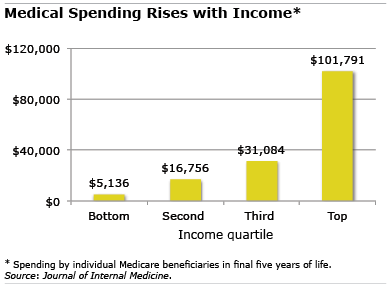
End-of-Life Medical Costs Vary Widely
Medical expenses increase unpredictably with age, so the crystal ball gets very hazy when trying to foretell how much you’ll need in retirement.
A new study helps clear things up: a single older American spends about $39,000 on average for medical care in the final five years of life, or about $7,800 a year. For couples in which one spouse has died, $51,000 was spent during that spouse’s final years, or about $10,000 annually.
These out-of-pocket expenses, which were reported by surviving spouses and family members, are for health care not covered by Medicare: insurance premiums, hospital and physician copayments and deductibles, and expenses for medications, nursing homes, and in-home care.
The data also show that the financial burden on older people varies greatly, not just depending on marital status but also income. High earners spend more than $100,000 in their last five years, reflecting the large amounts paid out by those who need – and can afford – long-term care.
The authors conclude that end-of-life medical expenses subject a significant minority of older Americans to “considerable financial risk.” Their evidence: for 43 percent of the people they studied, the medical bills accumulated during their last years exceeded the value of their financial assets, excluding home equity.
Preparing financially for rising medical expenses is a critical component of retirement planning. As people age, their spending on things like travel and entertainment may decline, freeing up income for medical bills. But then there’s a spike in end-of-life costs for medical care, requiring many people to deplete their savings.
The results of this study give individuals and financial planners something to work with when struggling to estimate how much they’ll need for medical costs.
But the short answer is: a lot.
Comments are closed.








In the few weeks before he died recently at 92, my uncle was hospitalized with a broken arm from a fall.
Doctors could do nothing for him other than a sling. They did, however, prescribe several tests and had him hooked up to monitoring devices for those weeks. Don’t know what the final cost was, but there was a lot of needless testing.